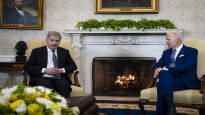The debate in Finland is closely followed in Washington’s security policy circles. Finland’s NATO revival is reminiscent of the Baltic states during the first war in Chechnya, says the historian who followed the enlargement negotiations in the 1990s.
Late last week, the president Sauli Niinistö arrived in Washington for a lightning-fast visit. Minister of Defense who traveled to the United States this week Antti Kaikkonen the visit was planned for a longer period, but in Washington security circles, both visits have received much attention.
– I and other former officials suspect that NATO was discussed, says a former NATO official Leo Michel Ylelle.
Michel is one of the Washington security policy professionals who monitors Finland’s security policy debate particularly closely. He has worked, among other things, as the head of the US Department of NATO, as an analyst for the CIA intelligence service and since then also for the Finnish Foreign Policy Institute.
According to Michelin, the political leadership of Finland and the United States has enough to discuss deepening co-operation between the two countries. And discussing NATO does not mean that Finland has actually started the NATO process.
It is a step towards NATO, but not a leap, Michel estimates.
– There is no question that bilateral cooperation with the United States will deepen understanding – and that is an important part of preparing for the negotiations. But it is an alliance where all allies need to work with Finland and understand what Finland could bring to the alliance, Michel says.
Michel has been following NATO negotiations in the U.S. civil service throughout the 1990s. He recalls that there are several time-consuming steps in the process.
They go something like this: once the political leadership has decided that Finland is considering membership, NATO can jointly decide on an invitation to NATO talks. After that, the Finns and NATO representatives will start negotiations. At the end of the process, NATO will ask again if you want to join. After that, all NATO countries must ratify the membership, after which it will be offered to Finland.
– There is no shortcut to this, although the process can be accelerated, Michel says.
– My guess is that negotiations can be accelerated in less than a year, but accession will not happen overnight.
Speculation about the direct security guarantees of the United States for Finland, which has been much talked about in Finland, is very unrealistic from Washington’s point of view. It is not US policy to provide bilateral security guarantees.
Michel also knocks out the idea. He said it would weaken NATO and other countries could start demanding guarantees from the United States past the alliance.
Similarities between Finland and the Baltic countries
Since 1994, Finland has been a NATO partner country through the so-called NATO Partnership for Peace program.
Having studied the history of NATO enlargement Mary Sarotten according to the Partnership for Peace was born in time as a result of NATO’s internal turmoil.
Some NATO countries wanted to expand the military alliance by including several countries at once, but only once. Britain, for example, believed that a single enlargement would have irritated Russia as little as possible.
The United States favored a tactic that offered many countries the opportunity for a partnership that could lead to membership. The United States also wanted to keep the door of NATO open to anyone who wants to in the future. The president at the time Bill Clinton believed it would not be as threatening to Russia as rapid enlargement.
Poland, the Czech Republic, and the Baltic countries were also first NATO partners in peace. According to Sarotte, the first war in Chechnya caused the former Soviet bloc countries to rush their membership.
– Russia’s attack on Chechnya was very violent. It made the countries of Central and Eastern Europe say that for a moment, we are not just happy with the partnership, we want to be full members, Sarotte says.
He says he fears Russia’s invasion of Ukraine may be as violent as the first Chechen war was.
As in the case of the Baltic countries and Poland in the 1990s, the Russian invasion has aroused growing interest in NATO in Finland.
– (President Vladimir) Putin the attack on Ukraine has shown a real threat, so support would be found for new NATO members. Especially when the Baltic countries are already members, Sarotte says.
According to him, Finland’s accession would increase the strategic depth of the military alliance and would be significant for the defense of the Baltics.
